This post will discuss the possible reasons for this error and provide a step-by-step guide on resolving it. If the Microsoft Passport Container service unexpectedly stopped after replacing secondary drive files, follow the solutions below to get it running again.
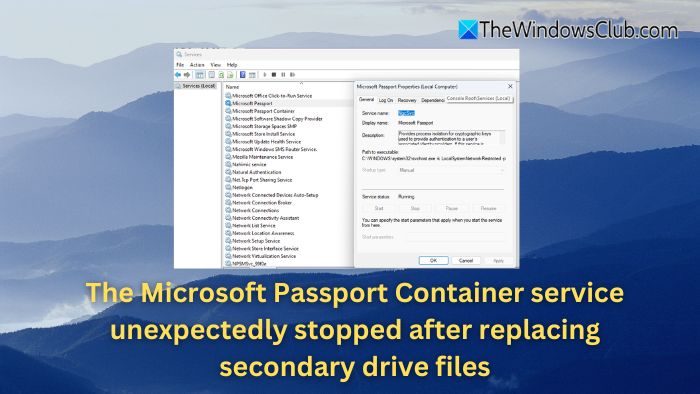
Unexpected stoppages can be frustrating when dealing with Windows services, especially with critical services like Microsoft Passport Container. This issue may arise after replacing files on a secondary drive, affecting essential Windows security and authentication services.
What is Microsoft Passport Container Service?
The Microsoft Passport Container service is a vital component that supports Windows Hello and other authentication mechanisms. It manages secure authentication tokens and data, making it essential for identity verification, logging in without passwords, and safeguarding user information.
When this service stops unexpectedly, it can disrupt login processes, security keys, and authentication systems tied to Microsoft accounts and domains.
The Microsoft Passport Container service unexpectedly stopped after replacing secondary drive files
Here are step-by-step solutions to resolve the unexpected stoppage of the Microsoft Passport Container service.
- Common Troubleshooting
- Reset Passport Container services to default
- Check Service dependencies
- Restore drive permissions
- Check the Event Viewer for error logs
- Reinstall Windows Hello components
You will need admin permission to execute these suggestions
1] Common Troubleshooting
Restart the PC with a Clean Boot to check if any third-party service causes the issue. If that comes out clean, try disabling the antivirus program. If nothing else works, you can run the SFC & DISM tool to replace any corrupt files that could be the reason for the issue. You can also run the error-checking tools to fix minor hardware issues.
2] Reset Passport Container services to default
Resetting all Windows services to their default state may help resolve service conflicts if the issue persists.
- Open Windows Terminal (Admin).
- Type the following commands to reset services to their default startup type:
- Press Enter and restart your system.
3] Check Service dependencies
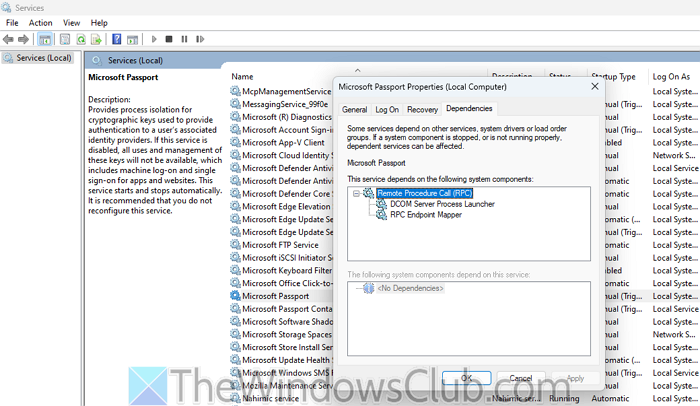
Services like Microsoft Passport Container rely on several other services to run correctly. Ensure that all dependencies are operational.
- Press Windows + R, type services.msc, and press Enter.
- Scroll down and find Microsoft Passport Container.
- Right-click and select Properties.
- Go to the Dependencies tab and note the dependent services.
- Ensure all dependent services (such as RPC Endpoint Mapper and DCOM Server Process Launcher) are running.
- If any dependent service is stopped, right-click and select Start.
4] Restore drive permissions
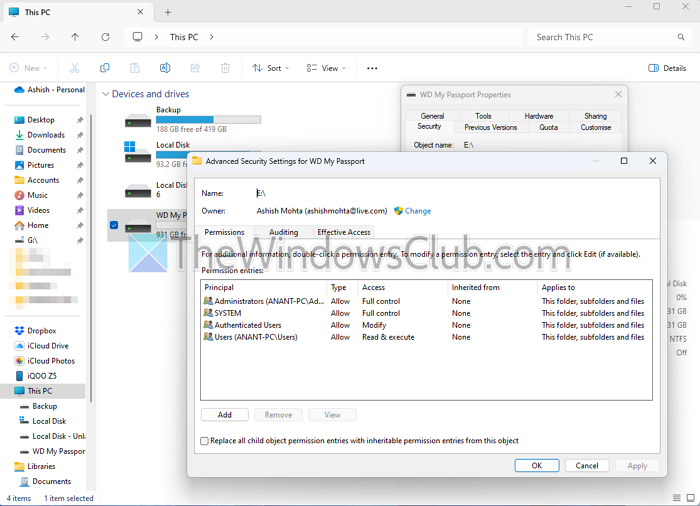
Replacing files on a secondary drive may alter permissions that services like Microsoft Passport Container need to function.
- Right-click the secondary drive in File Explorer and select Properties.
- Go to the Security tab.
- Click on Advanced to check the advanced permissions.
- Ensure that SYSTEM and Administrators have full control over the drive and its contents.
- If not, click Edit to update the permissions.
- Apply changes and restart the computer to check if the issue persists.
5] Check the Event Viewer for error logs
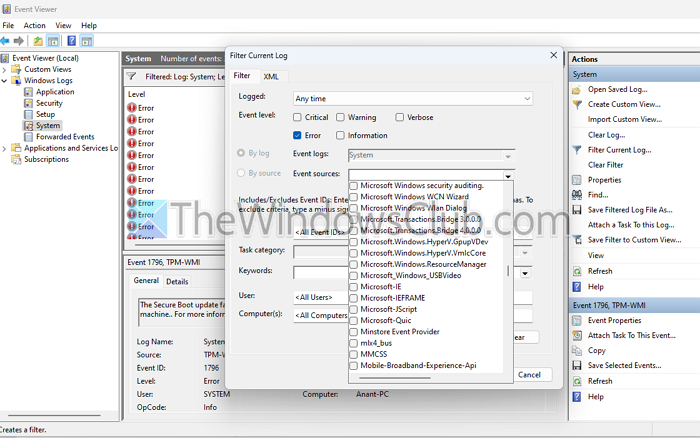
The Event Viewer provides detailed logs on system and service errors. Examining these logs can help identify the cause of the Passport Container service stoppage.
- Press Windows + X and select Event Viewer.
- In the left pane, expand Windows Logs and click on System.
- Look for error entries around the time the service stopped. Click Action > Filter Current Log to filter the logs, then select Error.
- Investigate any error related to the Microsoft Passport Container and note the error code or description for further troubleshooting.
- Search for solutions based on the specific error code found.
6] Reinstall Windows Hello components
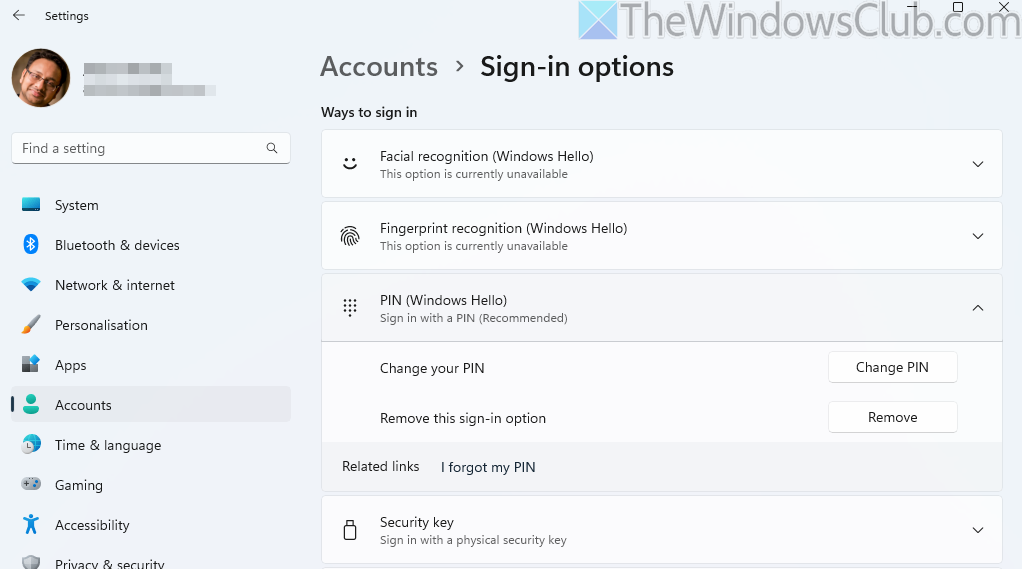
Reinstalling Windows Hello components can help refresh the files and services required by Microsoft Passport Container.
- Go to Settings > Accounts > Sign-in options.
- Under Windows Hello, remove any existing sign-in methods (such as PIN or fingerprint).
- Restart your computer.
- Return to Sign-in options and set up Windows Hello again.
- Check if the Passport Container service is now working as expected.
I hope these suggestions help to resolve the issue.
What signs are that Microsoft Passport Container service causing authentication issues?
When the Microsoft Passport Container service malfunctions, you might experience difficulty using Windows Hello features such as facial recognition, fingerprint login, or PIN authentication. Additionally, you could encounter error messages during login attempts, notice issues signing into Microsoft accounts or domain-based networks, or sudden prompts for credentials even if you are entering them correctly.
Will disabling the Microsoft Passport Container service affect my Windows login process?
Disabling or having the Microsoft Passport Container service stop unexpectedly can disrupt the Windows Hello login process. This service manages secure authentication, and if it fails, you may encounter issues with logging in through methods like facial recognition, fingerprint scanning, or PIN. It could also impact authentication for apps that rely on secure sign-ins, especially if they use Microsoft accounts or domain-based credentials.